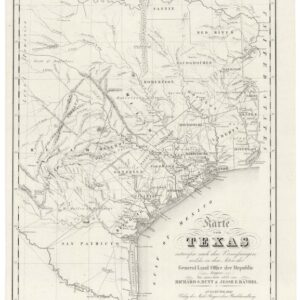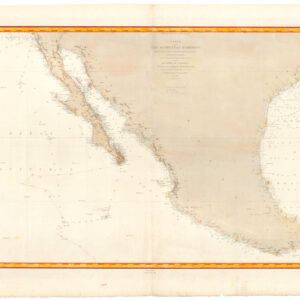A rare Gulf coast sea chart with the Republic of Texas and antebellum New Orleans.
Carta de las Costas de la Escambia, Alabama y Bocas de Rio Misisipi, la Luisiana, Tejas, con la Provincia del Nuevo Santander en el Golfo de Mejico…
Out of stock
Description
“The Gulf’s history…is America’s history; the energies of one are shared with the other.” (Davis, p. 7)
This rare, large-format Spanish Admiralty sea chart depicts the Gulf coast at a strategically important point in history, on the eve of the inclusion of the Republic of Texas into the United States and the outbreak of the Mexican-American War.
The mapped area extends along the Gulf of Mexico from the San Fernando River at present-day Matamoros past Corpus Christi and Galveston, New Orleans and the entrance to the Mississippi River, Mobile and Pensacola, finishing at Port St. Joe and Cape San Blas in Florida.
Of particular interest is the REPUBLICA DE TEJAS, engraved prominently spanning the area between the Nueces and Sabine Rivers.
The Republic of Texas was a sovereign nation in North America that existed from March 2, 1836, to February 19, 1846, although Mexico considered it a rebellious province during its entire existence. The region of the Mexican state of Coahuila y Tejas, now commonly referred to as Mexican Texas, declared its independence from Mexico during the Texas Revolution in 1835–1836, when the Centralist Republic of Mexico abolished autonomy from states of the Mexican federal republic. Texas was annexed by the United States on December 29, 1845 and was admitted to the Union as the 28th state on that day, with the transfer of power from the Republic to the new state of Texas formally taking place on February 19, 1846.
With touches of original color, the map traces the critical system of lighthouses along the coast. The Gulf coast is intersected by numerous important rivers, and is comprised of many inlets, bays, and lagoons. This made accurate sea charts like this one — with its wealth of information on depth soundings, coastal hazards, and navigational routes — especially valuable. Their value increased over the course of the 19th century, which saw the rising importance of the Gulf coast to the expanding United States.
As the U.S. population continued to expand its frontiers westward, the Gulf coast became a natural locus for growth. Its excellent harbors and connection to the Atlantic Ocean provided access to shipping lanes and both national and international commerce, especially trade in cotton and sugar.
Two Gulf Coast cities that prospered as a result of these circumstances were New Orleans and Galveston. By the mid 19th century New Orleans, being situated as the key link between the Mississippi River and the Gulf, had become the largest U.S. city not on the Atlantic seaboard and the fourth largest in the U.S. overall. The chart depicts the mouth of the Mississippi River in excellent detail, with New Orleans and several small towns located along the river.
For its part, Galveston was the most important city along the coast of the Republica de Tejas. Galveston Bay is the largest bay on the U.S. Gulf coast. The history of Galveston is intimately linked with the Texas Revolution. Not only was Galveston the naval base for the fleet which protected shipping and sought to prevent Mexican invasion of Texas by way of the sea, the city briefly served as the capital of the Texas Republic from the outset of the revolt until victory at the Battle of San Jacinto on April 21, 1836.
Also named on the map is an early appearance of the town of Corpus Christi, which was established as a permanent settlement in 1839 by Colonel Henry Lawrence Kinney and William P. Aubrey as Kinney’s Trading Post, or Kinney’s Ranch. In July 1845, U.S. troops commanded by General Zachary Taylor set up camp there in preparation for war with Mexico, and they remained until March 1846, the year this map was issued. About a year later, the settlement was officially named Corpus Christi and was incorporated on September 9, 1852.
The Gulf of Mexico is one of the largest estuary systems in the world. Running south from Corpus Christi Bay, we see the largest estuarine lagoon in Texas, Laguna Madre. The lagoon extends southward to the Rio Grande delta, a distance of some 115 miles. In the upper portion sits Baffin Bay, oddly named for an ice-bound counterpart off Greenland. Other estuaries, tidal flats, and bays are similarly mapped along the coast in excellent detail. It takes just a little imagination to picture the rich ecology of the Gulf coast, an environment buzzing with life: oysters, shrimp, crab, sea trout, manatees, turtles, a wide variety of birds, and many more.
The seal of the Direccion de Hidrografia appears at bottom right.
A Note on Rarity
This map appears to be quite rare, with only three institutional holdings listed on OCLC WorldCat, and a very limited auction and antiquarian market record.
Cartographer(s):
The Direccion Hidrografica de Madrid was an official institution established in Spain in 1797. It was charged with surveying and publishing important charts and maps from all over the world and became known for the quality of its execution and accuracy.
From its origins in the late 18th century as the Depósito Hidrográfico (1797), the institution that became the Dirección Hidrográfica centralized Spain’s naval cartography under royal patronage. Establishing dedicated surveying brigades, chart engraving workshops, and archival stores in Madrid transformed disparate coastal reconnaissances into a coherent national catalogue of “spherical charts.” These were designed to a uniform standard: using the prime meridian at Cádiz; scaling in Spanish nautical leagues, conforming projections, and systematising rhumb lines and sounding patterns.
In the first half of the 19th century, the Dirección Hidrográfica expanded its reach to Spain’s overseas domains. Drawing on commanders like Ángel Laborde in Havana or Cosme Churruca in the Antilles, it produced dozens of detailed charts covering the Gulf of Mexico, the Caribbean islands, West Africa, and the Philippines. The 1837 chart of Cuba’s northern and southern shores exemplifies their refined methodology: combining fresh hydrographic surveys with existing data, then entrusting the final composition to skilled delineators and engravers in Madrid. These charts underpinned Spain’s maritime operations and stand as enduring records of early‑modern nautical science and the continued global ambitions of the Spanish crown.
Juan CarrafaJuan Carrafa (1787-1869) was a prolific surveyor at the Direccion Hidrografica de Madrid.
Miguel MorenoMiguel Moreno was an engraver of charts and maps for the Direccion Hidrografica de Madrid.
Condition Description
Touches of original color. Wear and fraying along the margins.
References
OCLC (no. 5706219) records only holdings: Library of Congress, University of Texas Arlington, and Baylor University Libraries.
https://texashistory.unt.edu/ark:/67531/metapth298365/
Davis, J. E. (2018). The Gulf: The Making of an American Sea. W W Norton & Co.




